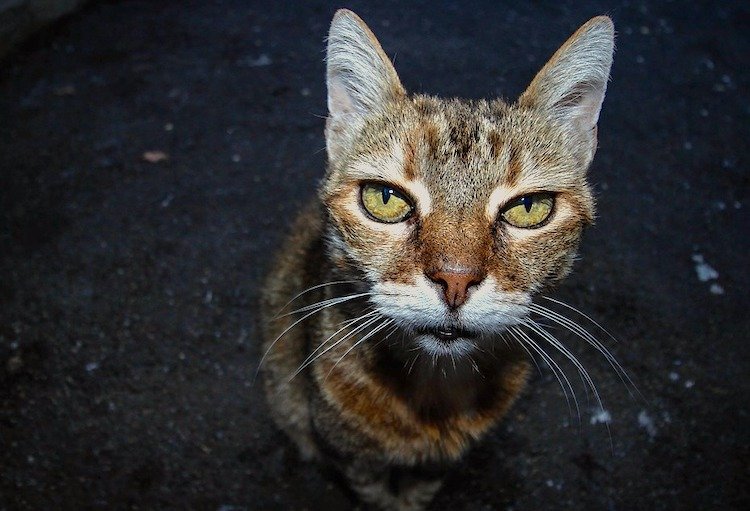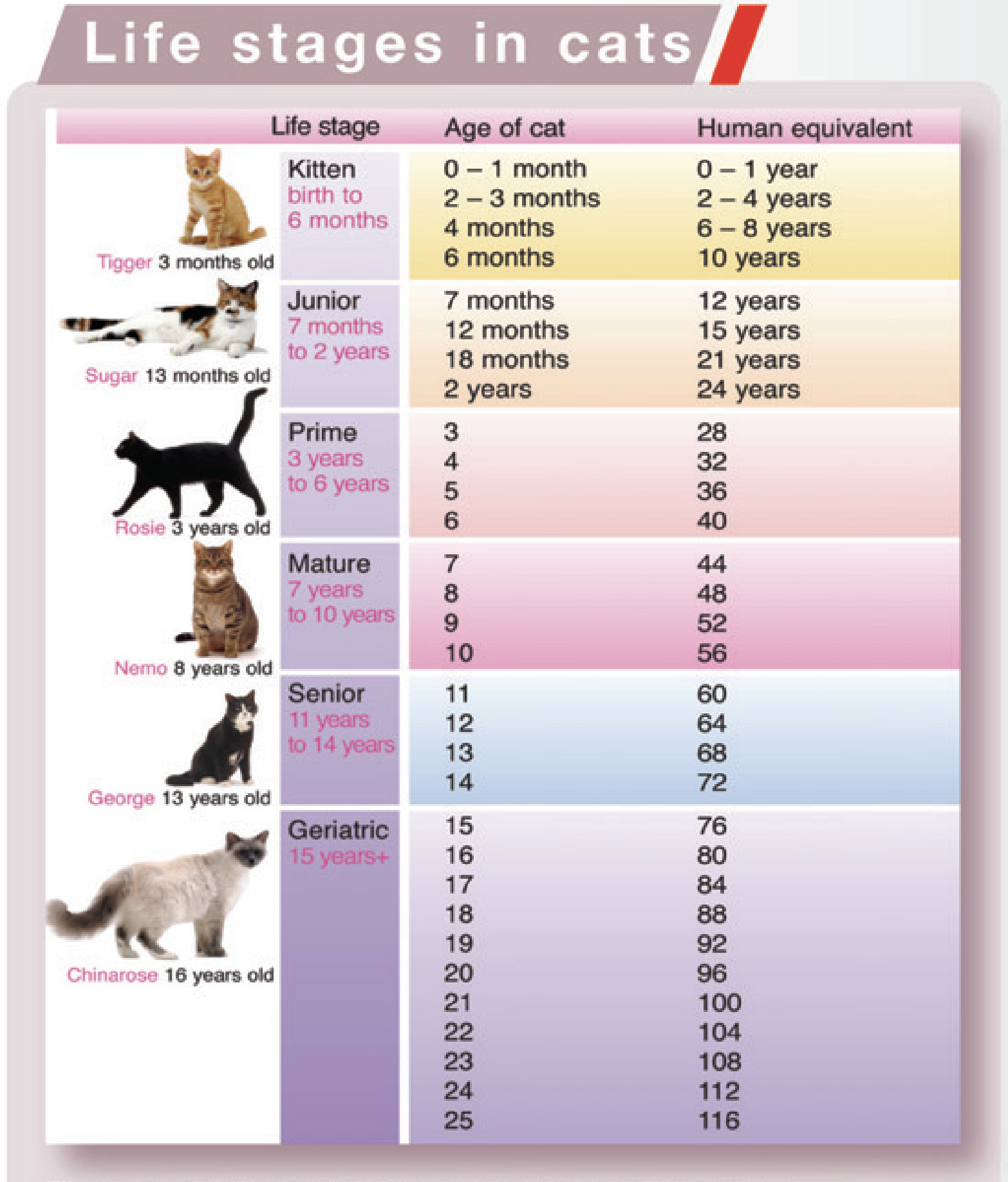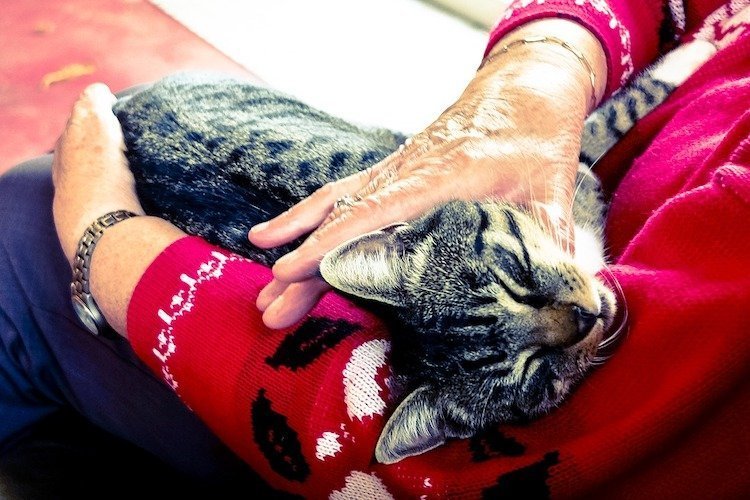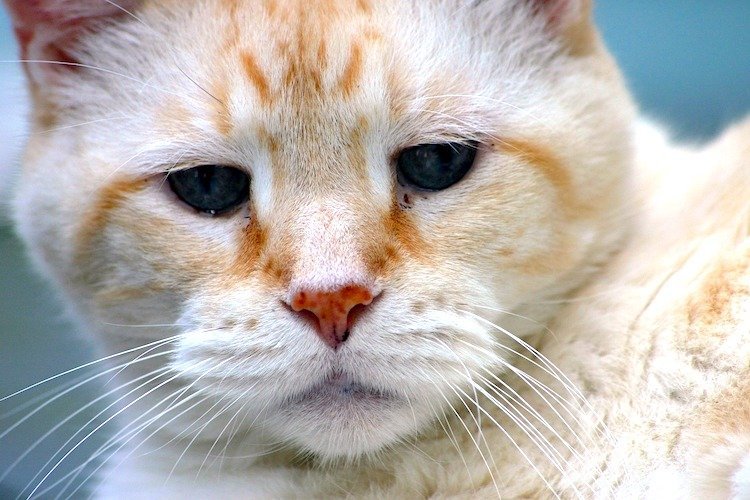
Our cats are living longer and longer. Veterinary medicine, educated pet parents and nutritional advances have greatly increased the lifespan of our beloved furry felines.
We get to enjoy our cats for a longer time, and many of our cats experience a good quality of life well into their geriatric years.
What is an old cat, anyway?
The American Association of Feline Practitioners (AAFP) and the American Animal Hospital Association (AAHA) divide a cat’s life into 6 stages:
- Kitten (newborn–6 months)
- Junior (7 months–2 years)
- Adult (3–6 years)
- Mature (7–10 years)
- Senior (11–14 years)
- Geriatric (15+ years)
Here’s what this looks like in chart form:

As a cat reaches the twilight years, people often say the cat is “slowing down.”
What does that mean? It can certainly mean your cat is getting older, but “slowing down” should not be excused away as the normal course of aging.
Remember, too, that cats are as individual as humans. One 14-year-old cat can look like some other 8-year-old cat. These life stages are general.
Even as the popularity of cats as America’s favorite pet continues to rise — with as many as 86 million cats kept as household pets versus up to 78 million dogs — people still take their dogs to the veterinarian twice as often as they do cats.
Cats also like to mask their diseases, making early detection of many geriatric problems difficult to notice.
People should become more aware of what to look for in the older cat and realize how important veterinary checkups are as their cat ages.
Here are some of the biggest reasons to pay special attention to the signs of cat aging:
- Improve quality of life and increase longevity
- Detect diseases earlier and lessen pain and suffering
- Reduce long-term health care costs and hospitalizations by early intervention

Top 4 Signs of Cat Aging
Let’s look at the 4 most common and significant signs of aging in cats:
1. Weight Loss and/or Decline in Body Condition
When you live with a pet day in and day out, it can be difficult to pick up on subtle changes in weight.
Awareness of weight change can be particularly difficult with older cats if they are obese, if the cat free feeds or if the cat lives in a multi-cat household.
Twice-yearly vet checks will monitor your cat’s weight effectively. As a veterinarian, I have found that people who have not been in for 6 months to 1 year are truly surprised to hear their geriatric cat has lost 10% of their body weight.
Changes in body condition may also be so subtle as to go unnoticed by someone who looks at their cat every day. Actual weight may not change, but a cat can begin to lose muscle mass and tone. Their skin can become thinner, or their hair coat dulls. These are not “normal” changes and should not be dismissed because the cat is aging.
Was YOUR Pet Food Recalled?
Check Now: Blue Buffalo • Science Diet • Purina • Wellness • 4health • Canine Carry Outs • Friskies • Taste of the Wild • See 200+ more brands…

A decrease in weight signals a medical or cognitive problem.
Obviously, a decreased appetite leads to weight loss, but some older cats continue to eat fairly steadily but show weight loss. This weight loss comes from the cat’s inability to absorb and use nutrients from food.
Dental or metabolic disease, GI disease, cancer, inflammatory or immune disease, neurologic problems, orthopedic disease or changes in cognitive function can lead to weight loss.
In other words, just about anything going on inside your cat’s aging body or mind can show up as weight loss.
- Don’t change your aging cat’s diet based on age alone.
- Don’t feed a “senior” or reduced-protein diet to an older cat unless your vet has diagnosed a disease that requires such a diet change. Many aging cats require more or a better source of protein, as well as supplements, to keep weight on and body condition up.
2. Changes in Thirst
Aging cats may be going to the water bowl more or less often.
- When a cat begins to drink a lot of water, most people notice this and bring them to the vet. The thirsty cat may have been drinking more water in secret, however, for several months before it became obvious. Routine geriatric blood tests and urinalyses can pick up on a cat’s excessive thirst before you ever notice it. Many diseases cause increased thirst, and all of them have a better prognosis if caught early.
- When a cat begins to drink less water, you may not notice. Getting to the bottom of this is twofold: We should find out not only why the cat is drinking less, but also counteract the dehydration that an inadequate amount of water intake can cause.
The cat may be going to the water bowl less because they don’t feel well, they’re losing some cognitive function and forget to drink, or they may be arthritic enough to forego that necessary trip to the water and just stay sleeping.
An older cat who stops drinking adequate water can become dehydrated more easily than a younger cat. If the cat has a smoldering illness, lack of water and dehydration can set the cat into crisis. Continual, low-grade dehydration is also a frequent cause of constipation in older cats.
In this video from Dr. Greg Martinez, DVM, an older cat was dehydrated and needed blood tests and rehydration to help her out:

3. Behavioral Changes: Cognitive Dysfunction (CD)
As our feline population lives longer, with many approaching or reaching 20-plus years, more and more people are observing major behavior changes and/or loss of cognitive function in their geriatric kitties.
Reporting and discussing these behavior changes with your vet is very important. Your observations matter most!
Behavior changes may signal an illness or cognitive dysfunction (CD), a form of feline dementia. Regardless of the cause, your vet can help improve quality of life for both you and your cat by treating the illness or the loss of mental capacity.
A change in vocalization is an important signal that something is wrong:
- If the sound of the meow is different, it could mean a medical problem. Your vet will do a thorough oral and throat exam and recommend further testing.
- If your elderly kitty begins to vocalize strangely, often at night, this could be a senile change, but medical conditions such as hypertension and hyperthyroidism can cause intense vocalization.
Many people hearing strange yowling worry their cat is in pain. While it is probably not intense physical pain, it clearly means the cat is experiencing anxiety — either from illness or loss of cognitive function.
Diagnosing the common medical conditions associated with vocalization is crucial. Early detection can prevent a serious event such as a stroke or cardiac event. Again, diagnosing and treating the vocalization improves quality of life for your cat and you.
Temperament changes, restlessness, changes in sleep patterns or changes in litter box behavior are common signs of reduced cognitive function.
These cats do best with very little change in environment. Trips to the vet should be as stressless as possible. Keeping anxiety to a minimum is one of the big challenges in this geriatric population.
4. Arthritis
Any changes in mobility should not be dismissed as “old age.”
Older cats may have severe arthritis, often in the hindquarters and/or the spine, that can be treated.
Many cats stop jumping to their usual spots or sometimes act aggressively when you try to move them. These subtle changes may mean the cat is experiencing chronic pain from osteoarthritis, and it should be addressed.

Older Cats Need Dedicated People
The thoughtful person with a geriatric cat will go to the vet at least twice a year; be observant of subtle changes in their kitty; and try to maintain a consistent, stress-free home environment.
Treating an older cat is a challenge. Many of our old boys and girls have multiple problems, adding to what vets call polypharmacy — meaning the cat should be on several medications.
Vets are highly aware that giving medications to cats is not easy. We have solved some of these problems by using compounding pharmacies. These special veterinary pharmacies can be helpful:
- Multiple medications can be put in a single capsule.
- Medications can be made into transdermal gels, which get absorbed into the skin.
- Meds can be flavored or put into a suspension.
Be aware that compounded meds are more expensive, though.
In the 1980s, my “old cat patients” were 14, maybe 15 years old. Now? They are 17, 18 and even 21.
We’ve come a long way, kitty! Let’s work together to keep up a happy, long life.
References
- Vogt, Amy Hoyumpa, DVM, DABVP, et al. “AAFP–AAHA Feline Life Stage Guidelines.” Journal of Feline Medicine and Surgery 12 (2010): 43–54. https://journals.sagepub.com/doi/pdf/10.1016/j.jfms.2009.12.006.
- “U.S. Pet (Dog and Cat) Population Fact Sheet.” American Humane Association. http://www.bradfordlicensing.com/documents/pets-fact-sheet.pdf.
- Gowan, Richard, BVSc (Hons), MACVSc. “Successful Implementation of a Feline Geriatric Health Program.” International Society of Feline Medicine. 2012.
- Landsberg, Gary, DVM, DACVB, DECVB-CA, et al. “Cognitive Dysfunction in Cats: A Syndrome We Used to Dismiss as ‘Old Age.'” Journal of Feline Medicine and Surgery 12, no. 11 (November 2010). 837-848. https://pubmed.ncbi.nlm.nih.gov/20974401/.
- Little, Susan, DVM, DABVP. “Life-Stage Care for Senior Cats.” International Society of Feline Medicine. 2013.
 This pet health content was written by a veterinarian, Dr. Debora Lichtenberg, VMD. It was last reviewed April 30, 2019.
This pet health content was written by a veterinarian, Dr. Debora Lichtenberg, VMD. It was last reviewed April 30, 2019. 

